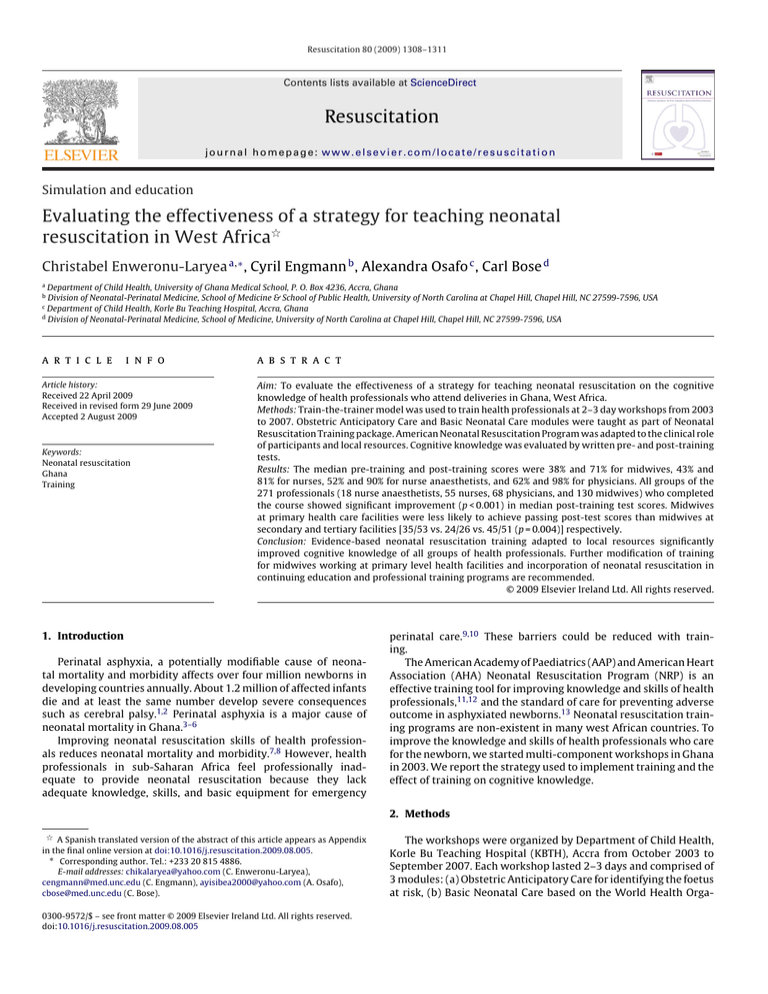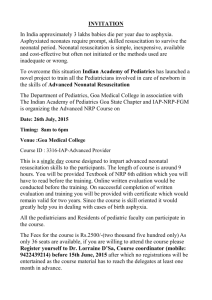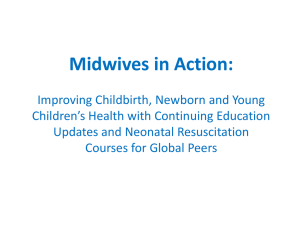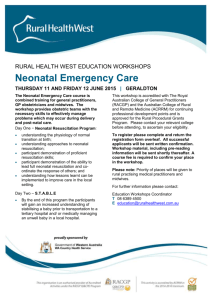
Resuscitation 80 (2009) 1308–1311
Contents lists available at ScienceDirect
Resuscitation
journal homepage: www.elsevier.com/locate/resuscitation
Simulation and education
Evaluating the effectiveness of a strategy for teaching neonatal
resuscitation in West Africa夽
Christabel Enweronu-Laryea a,∗ , Cyril Engmann b , Alexandra Osafo c , Carl Bose d
a
Department of Child Health, University of Ghana Medical School, P. O. Box 4236, Accra, Ghana
Division of Neonatal-Perinatal Medicine, School of Medicine & School of Public Health, University of North Carolina at Chapel Hill, Chapel Hill, NC 27599-7596, USA
c
Department of Child Health, Korle Bu Teaching Hospital, Accra, Ghana
d
Division of Neonatal-Perinatal Medicine, School of Medicine, University of North Carolina at Chapel Hill, Chapel Hill, NC 27599-7596, USA
b
a r t i c l e
i n f o
Article history:
Received 22 April 2009
Received in revised form 29 June 2009
Accepted 2 August 2009
Keywords:
Neonatal resuscitation
Ghana
Training
a b s t r a c t
Aim: To evaluate the effectiveness of a strategy for teaching neonatal resuscitation on the cognitive
knowledge of health professionals who attend deliveries in Ghana, West Africa.
Methods: Train-the-trainer model was used to train health professionals at 2–3 day workshops from 2003
to 2007. Obstetric Anticipatory Care and Basic Neonatal Care modules were taught as part of Neonatal
Resuscitation Training package. American Neonatal Resuscitation Program was adapted to the clinical role
of participants and local resources. Cognitive knowledge was evaluated by written pre- and post-training
tests.
Results: The median pre-training and post-training scores were 38% and 71% for midwives, 43% and
81% for nurses, 52% and 90% for nurse anaesthetists, and 62% and 98% for physicians. All groups of the
271 professionals (18 nurse anaesthetists, 55 nurses, 68 physicians, and 130 midwives) who completed
the course showed significant improvement (p < 0.001) in median post-training test scores. Midwives
at primary health care facilities were less likely to achieve passing post-test scores than midwives at
secondary and tertiary facilities [35/53 vs. 24/26 vs. 45/51 (p = 0.004)] respectively.
Conclusion: Evidence-based neonatal resuscitation training adapted to local resources significantly
improved cognitive knowledge of all groups of health professionals. Further modification of training
for midwives working at primary level health facilities and incorporation of neonatal resuscitation in
continuing education and professional training programs are recommended.
© 2009 Elsevier Ireland Ltd. All rights reserved.
1. Introduction
Perinatal asphyxia, a potentially modifiable cause of neonatal mortality and morbidity affects over four million newborns in
developing countries annually. About 1.2 million of affected infants
die and at least the same number develop severe consequences
such as cerebral palsy.1,2 Perinatal asphyxia is a major cause of
neonatal mortality in Ghana.3–6
Improving neonatal resuscitation skills of health professionals reduces neonatal mortality and morbidity.7,8 However, health
professionals in sub-Saharan Africa feel professionally inadequate to provide neonatal resuscitation because they lack
adequate knowledge, skills, and basic equipment for emergency
perinatal care.9,10 These barriers could be reduced with training.
The American Academy of Paediatrics (AAP) and American Heart
Association (AHA) Neonatal Resuscitation Program (NRP) is an
effective training tool for improving knowledge and skills of health
professionals,11,12 and the standard of care for preventing adverse
outcome in asphyxiated newborns.13 Neonatal resuscitation training programs are non-existent in many west African countries. To
improve the knowledge and skills of health professionals who care
for the newborn, we started multi-component workshops in Ghana
in 2003. We report the strategy used to implement training and the
effect of training on cognitive knowledge.
2. Methods
夽 A Spanish translated version of the abstract of this article appears as Appendix
in the final online version at doi:10.1016/j.resuscitation.2009.08.005.
∗ Corresponding author. Tel.: +233 20 815 4886.
E-mail addresses: chikalaryea@yahoo.com (C. Enweronu-Laryea),
cengmann@med.unc.edu (C. Engmann), ayisibea2000@yahoo.com (A. Osafo),
cbose@med.unc.edu (C. Bose).
0300-9572/$ – see front matter © 2009 Elsevier Ireland Ltd. All rights reserved.
doi:10.1016/j.resuscitation.2009.08.005
The workshops were organized by Department of Child Health,
Korle Bu Teaching Hospital (KBTH), Accra from October 2003 to
September 2007. Each workshop lasted 2–3 days and comprised of
3 modules: (a) Obstetric Anticipatory Care for identifying the foetus
at risk, (b) Basic Neonatal Care based on the World Health Orga-
C. Enweronu-Laryea et al. / Resuscitation 80 (2009) 1308–1311
1309
Table 1
Place of work of health professionals.
Tertiary level health facility
Mid wives (n = 130)
Nurse (n = 55)
Nurse anaesthetists (n = 18)
Physicians (n = 68)
Total
Secondary level health facility
Primary level health facility
51
20
–
46
26
35
18
22
53
–
–
–
117
101
53
Table 2
Neonatal Resuscitation Program (NRP) median (interquartile range) test scores of participants.
NRP tests (maximum score)
Pre-test (21)
Lesson 1 (13)
Lesson 2 (13)
Lesson 3 (19)
Lesson 4 (14)
Lesson 5 (13)
Lesson 6 (13)
Lesson 7 (13)
Post-test (21)
Mid wives (n = 130)
Nurse (n = 55)
Nurse anaesthetists (n = 18)
Physicians (n = 68)
8 (7–11)
8 (7–10)
7 (6–9)
11 (9–13)
11 (8–13)
–
–
–
15 (13–17)
9 (7–12)
10 (8–11)
9 (7–11)
12 (11–14)
12 (12–13)
–
–
–
17 (15–19)
11 (10–13)
9.5 (8–10)
10 (9–11)
13 (12–14)
12 (10–13)
–
–
–
19 (17–19)
13 (12–15)
11(10–12.5)
10 (8–11)
14 (10.5–16)
12 (8.5–14)
12 (11–13)
12 (10–13)
–
20.5 (19–21)
nization (WHO) Integrated Management of Childhood Illnesses
and Essential Newborn Care Program, and (c) Neonatal Resuscitation based on the fourth edition of the AAP/AHA NRP.14 Training
comprised of didactic lectures, interactive and hands-on practical sessions, and train-the-trainer model for neonatal resuscitation
module.
2.1. Participants and instructors
Participants were midwives, nurses from acute obstetric and
neonatal units, residents in obstetrics and paediatrics, medical officers in secondary level health facilities, and nurse anaesthetists.
Each workshop had 30–50 participants. The first workshop was
conducted by volunteer neonatal resuscitation training instructors
from United States of America (USA). They provided training equipment and trained 10 trainers. These 10 trainers (2 nurses and 8
physicians) from KBTH formed the core trainers for subsequent
workshops.
2.2. Neonatal resuscitation training module
We taught the seven lessons of NRP [(i) principles of resuscitation; (ii) initial steps in resuscitation; (iii) bag and mask ventilation;
(iv) chest compressions; (v) endotracheal intubation; (vi) medications; (vii) special considerations], but minimized emphasis on
endotracheal intubation and medications for nurses and midwives.
The Special Considerations lesson was adapted to local context.
We ensured comprehension of the subject by: (a) teaching a maximum of two lessons per day to nurses and midwives and spending
more time on practical sessions; (b) discussion of test questions
for each lesson after presentation and evaluation of that lesson;
and (c) extra tutorial for participants with unsatisfactory practical
skills.
2.3. Evaluation of effect of training on cognitive knowledge and
practical skills
The NRP evaluation multiple choice and fill-in questions were
administered for each lesson taught. The results of the 21-question
pre- and post-tests which cover all aspects of the module were
used to assess change in cognitive knowledge. Physicians were
taught the entire NRP and the passing score was 85% which
is consistent with the NRP in USA. We defined passing score
among non-physicians as 60%; this is equivalent to 85% of the
pre- and post-test questions relating to lessons they had formal
presentations on. Practical skills were assessed by direct observation of mock clinical scenarios using a performance checklist.
However, effect of training on practical skills was not analysed
because it was logistically difficult to do it formally on all participants.
2.4. Statistical analysis
Data were analysed with Sigma Stat for Windows Version 3.11
(Systat Software Inc., USA). We used Wilcoxon signed rank test
to compare the difference between pre- and post-test scores for
health professional groups, and Chi-square analysis to compare the
performance of midwives at different health facility levels.
3. Results
Of the 314 participants at 7 workshops; 271 (18 nurse anaesthetists, 55 nurses, 68 physicians, and 130 midwives) completed
the lessons. We excluded 43 participants (28 physicians and 14
midwives from KBTH, and 1 nurse from secondary health facility)
who partially attended the workshops. Most (38/43) excluded participants had to leave the workshop to attend emergencies. Table 1
shows the levels of health facilities of participants. Most midwives
Table 3
Improvement in health professional pre- and post-test scores after Neonatal Resuscitation Program training.
Status
Midwives (n = 130)
Nurses (n = 55)
Nurse anaesthetists (n = 18)
Physicians (n = 68)
Median pre-test score % (IQR)
Median post-test score% (IQR)
Median improvement from pre-test (%)
p-value
38 (33–52%)
43 (33–57%)
52 (48–62%)
62 (57–71%)
71 (62–81%)
81 (71–90)
90 (81–90)
98 (81–98%)
87
89
72
58
<0.001
<0.001
<0.001
<0.001
1310
C. Enweronu-Laryea et al. / Resuscitation 80 (2009) 1308–1311
were from primary (41%) and tertiary (39%) facilities while majority
of nurses (64%) were from secondary health facilities.
Table 2 shows evaluation test scores. Midwives had the lowest
scores for all lessons; the performance of physicians was similar to
nurse anaesthetists. Table 3 shows the effect of training on cognitive knowledge based on the difference between pre- and post-test
scores for each professional group. Nurses and midwives demonstrated the least cognitive knowledge before training, but also the
highest improvement in cognitive knowledge following training.
Thirty one participants (1 midwife, 5 nurses and 25 physicians)
with high test scores and good practical skills volunteered to be
trained as trainers; 10 at the first workshop (core trainers) and 21
at subsequent workshops.
Twenty percent (26/130) of midwives failed to achieve the
post-test passing score after the initial training; 69% (18/26) of
these were from primary health facilities. Midwives from primary
health facilities were less likely to achieve a passing score compared to midwives from secondary and tertiary facilities [35/53
(66%) vs. 24/26 (92%) vs. 45/51 (88%), p = 0.004, 95% CI 3.81–21.92]
respectively. Although not formally assessed, we observed that participants with low test scores were slower at acquiring practical
skills.
nurse anaesthetists as trainers will promote a sustainable program
and build capacity for skilled neonatal resuscitation at all levels of
perinatal care.
Our work has some limitations. Although we used validated
materials for NRP and Newborn Care modules, the Obstetric Anticipatory Care module content was not validated. Validation and
exploration of the benefits of this module appear warranted. We
evaluated the effectiveness of training on only cognitive knowledge; it would have been preferable to also evaluate practical skills.
However, the real test is whether the knowledge and skills are
retained over time to improve practices that save newborn lives
in labour rooms.
5. Conclusion
Sustaining evidence-based neonatal resuscitation training program is feasible in west Africa; however, scaling up requires the
involvement of Ministry of Health. Training programs should be
adapted to the local human and infrastructural resources to ensure
effectiveness. Incorporating neonatal resuscitation in continuing
education and professional training programs is recommended.
Conflict of interest statement
4. Discussion
We have shown that AAP/AHA NRP can be used to improve the
cognitive knowledge of health professionals on neonatal resuscitation in Ghana. The highest improvement occurred in nurses and
midwives, but the performance of midwives at primary health facilities was significantly lower than those at secondary and tertiary
facilities. The train-the-trainer model sustained the program.
Our holistic approach to incorporate the 3 modules was to
enable participants understand the complex relationship between
obstetrics and newborn care and modern concepts of neonatal
resuscitation. We minimized emphasis on endotracheal intubation and medications for non-physicians because these were not
applicable to their professional roles. This adaptation is consistent
with NRP recommendations of targeting training to conform to the
professional roles of learners.
The improvement in cognitive knowledge we observed is similar to data from other developing countries.15–17 An important
finding in our cohort is that nurses and midwives who are the vanguard of acute obstetric and neonatal care in west Africa had the
highest percentage increase in cognitive knowledge. We speculate
that concerted effort to train them in emergency perinatal care will
improve clinical skills that save newborn lives.
The performance of midwives at primary health facilities may
have resulted from the extensive information we presented in a
relatively short period of time. Many of these midwives were not
familiar with current newborn resuscitation principles and some
had never used a resuscitation bag; however, 66% achieved pass
post-test scores after one workshop. We ensured that all participants had satisfactory practical skills irrespective of their test score.
Longer training periods and alternate educational techniques (e.g.
further simplification of NRP) should be explored for this group of
midwives.
Train-the-trainer model increases knowledge, promotes ownership, builds capacity and enables sustainability of programs.18
These qualities are important for sustaining clinical skills in west
African health professionals. Midwives and nurse anaesthetists
were under-represented in our cohort of volunteer trainers partly
because of their clinical workload. Nurse anaesthetists are principal
providers of anaesthesia for operative obstetric care in secondary
health facilities in west Africa and most midwives are sole practitioners in their primary health facility. Training midwives and
Authors have no conflict of interest to declare.
Acknowledgements
We wish to acknowledge Dr Richard Bell MD, Northbay Medical Centre, Fairfield, California the leader of NRP instructors who
organized the first workshop and provided the Department of
Child Health, KBTH with training equipment. We wish to acknowledge volunteer instructors from Kybele Incorporated, University of
North Carolina, and Pediatrix group of Texas for their help in providing free resuscitation bags for the health facilities and training
the trainers.
References
1. Azra Haider B, Bhutta ZA. Birth asphyxia in developing countries: current status and public health implications. Curr Probl Pediatr Adolesc Health Care
2006;36:178–88.
2. Hyder Adnan A, Wali Salman A, McGuckin Jeffery. The burden of disease
from neonatal mortality: a review of South Asia and Sub-Saharan Africa. BJOG
2003;110:894–901.
3. Welbeck J, Biritwum RB, Mensah G. Factors affecting the survival of the “at
risk” newborn at Korle Bu Teaching Hospital, Accra, Ghana. West Afr J Med
2003;22:55–8.
4. Baiden F, Hodgson A, Adjuik M, Adongo P, Ayaga B, Binka F. Trend and causes
of neonatal mortality in the Kassena–Nankana district of northern Ghana,
1995–2002. Trop Med Int Health 2006;11:532–9.
5. Enweronu-Laryea CC, Nkyekyer K, Rodrigues OP. The impact of improved neonatal intensive care facilities on referral pattern and outcome at a teaching hospital
in Ghana. J Perinatol 2008;28:561–5.
6. Pond B, Addai E, Kwashie ST. Stagnation of Ghana’s under-5 mortality rate. The
Lancet 2005;365:1846.
7. Duran R, Aladağ N, Vatansever U, Süt N, Acunaş B. The impact of neonatal resuscitation program courses on mortality and morbidity of newborn infants with
perinatal asphyxia. Brain Dev 2008;30:43–6.
8. O’Hare BA, Nakakeeto M, Southall DP. A pilot study to determine if nurses trained
in basic neonatal resuscitation would impact the outcome of neonates delivered
in Kampala, Uganda. J Trop Paediatr 2006;52:376–9.
9. Bream KD, Gennaro S, Kafulafula U, Mbweza E, Hehir D. Barriers to and facilitators for newborn resuscitation in Malawi, Africa. J Midwifery Women’s Health
2005:329–34.
10. Pettersson KO, Johansson E, Pelembe Mde F, Dgedge C, Christensson K. Mozambican midwives’ views on barriers to quality perinatal care. Health Care Women
Int 2006;2:145–68.
11. Deorari AK, Paul VK, Singh M, Vidyasagar D, Medical Colleges N. Impact of education and training on neonatal resuscitation practices in 14 teaching hospitals
in India. Ann Trop Paediatr 2001;21:29–33.
12. Ryan CA, Clark LM, Malone A, Ahmed S. The effect of a structured neonatal resuscitation program on delivery room practices. Neonatal Netw 1999;18:25–30.
13. Wiswell TE. Neonatal resuscitation. Respir Care 2003;48:288–95.
C. Enweronu-Laryea et al. / Resuscitation 80 (2009) 1308–1311
14. American Academy of Paediatrics Committee on Foetus and Newborn, American Heart Association Sub-committee on Paediatric Resuscitation, International
Liaison Committee on Resuscitation Paediatric Working Group, et al. Neonatal
resuscitation textbook. 4th edition United States of America: American Academy
of Paediatrics and American Heart Association; 2000.
15. Trevisanuto D, Ibrahim SA, Doglioni N, Salvadori S, Ferrarese P, Zanado V.
Neonatal resuscitation courses for paediatric residents: comparison between
Khartoum (Sudan) and Padova (Italy). Paediatr Anaesth 2007;17:28–31.
1311
16. Ergenekon E, Koc E, Atalay Y, Soysal S. Neonatal resuscitation course experience
in Turkey. Resuscitation 2000;45:225–7.
17. Opiyo N, Were F, Govedi F, et al. Effect of newborn resuscitation training on
health worker practices in Pumwani Hospital, Kenya. PLoS ONE 2008;3:e1599.
doi:10.1371/journal.pone.0001599.
18. Orfaly R, Frances J, Campbell P, Whittemore B, Jolly B, Koh H. Train-the-trainer
as an educational model in public health preparedness. J Public Health Manag
Pract 2005;11:S123–7.




